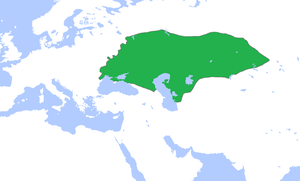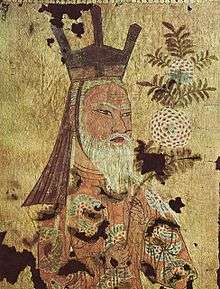Turkic peoples
The Turkic peoples are a collection of ethnic groups of Central, East, North and West Asia as well as parts of Europe and North Africa, who speak Turkic languages.[31][32]
Türk, 突厥 | |
|---|---|
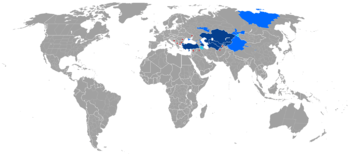 | |
| Total population | |
| Approx. 140–160 million[1][2] or over 170 million[3] | |
| Regions with significant populations | |
| 57,500,000–61,500,000[4] | |
| 25,200,000[5] | |
| 15,000,000-20,000,000[6][7] 18% of population[8] | |
| 12,751,502 | |
| 12,300,000[9] | |
| 11,647,000[10] | |
| 10,000,000[11] | |
| 5,876,318 | |
| 4,500,000[12] | |
| 4,500,000[13] | |
| 3,500,000[14] | |
| 3,000,000[15][16] | |
| 1,200,000[17] | |
| 1,000,000+[18] | |
| 800,000–1,000,000+[19] | |
| 588,318[20] | |
| 398,600[21] | |
| 313,626[22] | |
| 293,500 | |
| 224,460 | |
| 202,086[23] | |
| 200,000[24][25][26][27] | |
| 126,010[28] | |
| 81,900[29][30] | |
| Languages | |
| Turkic languages | |
| Religion | |
Majority:
Minority:
| |
The origins of the Turkic peoples has been a topic of much discussion.[33] Recent linguistic, genetic and archaeological evidence suggests that the earliest Turkic peoples descended from agricultural communities in Northeast China who moved westwards into Mongolia in the late 3rd millennium BC, where they adopted a pastoral lifestyle.[34][35][36][37] By the early 1st millennium BC, these peoples had become equestrian nomads.[34] In subsequent centuries, the steppe populations of Central Asia appear to have been progressively Turkified by a heterogenous East Asian dominant minority moving out of Mongolia.[38][39] Many vastly differing ethnic groups have throughout history become part of the Turkic peoples through language shift, acculturation, intermixing, adoption and religious conversion.[3] Nevertheless, certain Turkic peoples share, to varying degrees, non-linguistic characteristics like cultural traits, ancestry from a common gene pool, and historical experiences.[3]
The most notable modern Turkic-speaking ethnic groups include Turkish people, Azerbaijanis, Uzbeks, Kazakhs, Turkmens, Kyrgyz and Uyghur people.
Etymology
The first known mention of the term Turk (Old Turkic: 𐱅𐰇𐰼𐰰 Türük or 𐱅𐰇𐰼𐰰:𐰜𐰇𐰛 Kök Türük Chinese: 突厥, Old Tibetan: duruggu/durgu (meaning 'origin'),[40][41][42][43] Pinyin: Tūjué, Middle Chinese (Guangyun): [tʰuot-küot]) applied to a Turkic group was in reference to the Göktürks in the 6th century (in the Khüis Tolgoi inscription, most likely not later than 587 AD). A letter by Ishbara Qaghan to Emperor Wen of Sui in 585 described him as "the Great Turk Khan".[44][45] The Bugut (584 CE) and Orkhon inscriptions (735 CE) use the terms Türküt, Türk and Türük.[46]
Previous use of similar terms are of unknown significance, although some strongly feel that they are evidence of the historical continuity of the term and the people as a linguistic unit since early times. This includes the Chinese Spring and Autumn Annals, which refer to a neighbouring people as Beidi.[47] During the first century CE, Pomponius Mela refers to the Turcae in the forests north of the Sea of Azov, and Pliny the Elder lists the Tyrcae among the people of the same area.[48][49][50] There are references to certain groups in antiquity whose names could be the original form of Tür(ü)k such as Togarma, Turukha/Turuška, Turukku and so on. But the information gap is so substantial that a connect of these ancient people to the modern Turks is not possible.[51][52] Turkologist Peter B. Golden posits that the term Turk has roots in Old Turkic.[53]
It is generally accepted that the name Türk is ultimately derived from the Old-Turkic migration-term[54] 𐱅𐰇𐰼𐰰 Türük/Törük,[55] which means 'created, born'[56] or 'strong',[57] from the Old Turkic word root *türi-/töri- 'tribal root, (mythic) ancestry; take shape, to be born, be created, arise, spring up' and derived with the Old Turkic suffix 𐰰 (-ik), perhaps from Proto-Turkic *türi-k 'lineage, ancestry',[55][58] (compare also the Proto-Turkic word root *töre- to be born, originate').[59] Scholars, including Toru Haneda, Onogawa Hidemi, and Geng Shimin believed that Di, Dili, Dingling, Chile and Tujue all came from the Turkic word Türk, which means means 'powerful' and 'strength', and its plural form is Türküt.[60] Even though Gerhard Doerfer supports the proposal that türk means 'strong' in general, Gerard Clauson points out that "the word türk is never used in the generalized sense of 'strong'" and that türk was originally a noun and meant "'the culminating point of maturity' (of a fruit, human being, etc.), but more often used as an [adjective] meaning (of a fruit) 'just fully ripe'; (of a human being) 'in the prime of life, young, and vigorous'".[61]
The earliest Turkic-speaking peoples identifiable in Chinese sources are the Dingling, Gekun, and Xinli, located in South Siberia.[62][63] The Chinese Book of Zhou (7th century) presents an etymology of the name Turk as derived from 'helmet', explaining that this name comes from the shape of a mountain where they worked in the Altai Mountains.[64] Hungarian scholar András Róna-Tas (1991) pointed to a Khotanese-Saka word, tturakä 'lid', semantically stretchable to 'helmet', as a possible source for this folk etymology, yet Golden thinks this connection requires more data.[65]
During the Middle Ages, various Turkic peoples of the Eurasian steppe were subsumed under the "umbrella-identity" of the "Scythians". Between 400 CE and the 16th century, Byzantine sources use the name Σκύθαι (Skuthai) in reference to twelve different Turkic peoples.[66]
In the modern Turkish language as used in the Republic of Turkey, a distinction is made between "Turks" and the "Turkic peoples" in loosely speaking: the term Türk corresponds specifically to the "Turkish-speaking" people (in this context, "Turkish-speaking" is considered the same as "Turkic-speaking"), while the term Türki refers generally to the people of modern "Turkic Republics" (Türki Cumhuriyetler or Türk Cumhuriyetleri). However, the proper usage of the term is based on the linguistic classification in order to avoid any political sense. In short, the term Türki can be used for Türk or vice versa.[67]
List of ethnic groups
- Historical Turkic groups
- Dingling
- Bulgars
- Alat
- Basmyl
- Onogurs
- Saragurs
- Sabirs
- Shatuo
- Yueban
- Göktürks
- Oghuz Turks
- Kankalis
- Khazars
- Kipchaks
- Kumans
- Karluks
- Tiele
- Turgesh
- Yenisei Kirghiz
- Chigils
- Toquz Oghuz
- Yagma
- Nushibi
- Kutrigurs
- Duolu
- Yabaku
- Bulaqs
- Xueyantuo
- Chorni Klobuky
- Berendei
- Naimans (partly)
- Keraites (partly)
- Merkits (partly)[68]
Possible Proto-Turkic ancestry, at least partial[69][70][71][72][73][74], has been posited for Xiongnu, Huns and Pannonian Avars, as well as Tuoba and Rouran (later Tatars), who were of Proto-Mongolic Donghu ancestry.[75][76][77][78][79][lower-alpha 1]
Notes
- Even though Chinese historians routinely ascribed Xiongnu origin to various nomadic peoples, such ascriptions do not necessarily indicate the subjects' exact origins; for examples, Xiongnu ancestry was ascribed to Turkic-speaking Tujue and Tiele as well as Para-Mongolic-speaking Kumo Xi and Khitan.[80]
Language
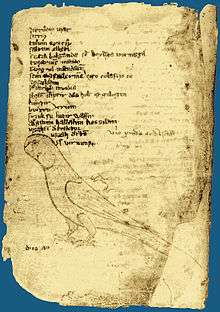
Distribution
The Turkic languages constitute a language family of some 30 languages, spoken across a vast area from Eastern Europe and the Mediterranean, to Siberia and Western China, and through to the Middle East. Some 170 million people have a Turkic language as their native language;[81] an additional 20 million people speak a Turkic language as a second language. The Turkic language with the greatest number of speakers is Turkish proper, or Anatolian Turkish, the speakers of which account for about 40% of all Turkic speakers.[82] More than one third of these are ethnic Turks of Turkey, dwelling predominantly in Turkey proper and formerly Ottoman-dominated areas of Southern and Eastern Europe and West Asia; as well as in Western Europe, Australia and the Americas as a result of immigration. The remainder of the Turkic people are concentrated in Central Asia, Russia, the Caucasus, China, and northern Iraq.
Alphabet
The Turkic alphabets are sets of related alphabets with letters (formerly known as runes), used for writing mostly Turkic languages. Inscriptions in Turkic alphabets were found in Mongolia. Most of the preserved inscriptions were dated to between 8th and 10th centuries CE.
The earliest positively dated and read Turkic inscriptions date from c. 150, and the alphabets were generally replaced by the Old Uyghur alphabet in the Central Asia, Arabic script in the Middle and Western Asia, Cyrillic in Eastern Europe and in the Balkans, and Latin alphabet in Central Europe. The latest recorded use of Turkic alphabet was recorded in Central Europe's Hungary in 1699 CE.
The Turkic runiform scripts, unlike other typologically close scripts of the world, do not have a uniform palaeography as, for example, have the Gothic runes, noted for the exceptional uniformity of its language and paleography.[83] The Turkic alphabets are divided into four groups, the best known of them is the Orkhon version of the Enisei group. The Orkhon script is the alphabet used by the Göktürks from the 8th century to record the Old Turkic language. It was later used by the Uyghur Empire; a Yenisei variant is known from 9th-century Kyrgyz inscriptions, and it has likely cousins in the Talas Valley of Turkestan and the Old Hungarian script of the 10th century. Irk Bitig is the only known complete manuscript text written in the Old Turkic script.[84]
The Turkic language family is traditionally considered to be part of the proposed Altaic language family.[85]
The various Turkic languages are usually considered in geographical groupings: the Oghuz (or Southwestern) languages, the Kypchak (or Northwestern) languages, the Eastern languages (like Uygur), the Northern languages (like Altay and Yakut), and one existing Oghur language: Chuvash (the other Oghur languages, like Volga Bulgarian, are now extinct). The high mobility and intermixing of Turkic peoples in history makes an exact classification extremely difficult.
The Turkish language belongs to the Oghuz subfamily of Turkic. It is for the most part mutually intelligible with the other Oghuz languages, which include Azerbaijani, Gagauz, Turkmen and Urum, and to a varying extent with the other Turkic languages.
Geographical distribution
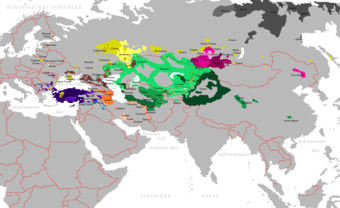

While the Turkic language and people may have originated in Mongolia,[86][3] today most of the Turkic peoples today have their homelands in Central Asia, but can be found as far west as present-day Turkey.[87] While the term "Turk" may refer to a member of any Turkic people, the term Turkish usually refers specifically to the people and language of the modern country of Turkey.
At present, there are six independent Turkic countries: Azerbaijan, Kazakhstan, Kyrgyzstan, Turkmenistan, Turkey, Uzbekistan. The Turks in Turkey are over 60 million[88] to 70 million worldwide, while the second largest Turkic people are the Azerbaijanis, numbering 22 to 38 million worldwide; most of them live in Azerbaijan and Iran.
In the Russian Federation there are several Turkic national subdivisions,[89] including Bashkortostan, Tatarstan, Chuvashia, Khakassia, Tuva, Yakutia, the Altai Republic, Kabardino-Balkaria, and Karachayevo-Cherkessiya. Each of these subdivisions has its own flag, parliament, laws, and official state language (in addition to Russian).
The Xinjiang Uyghur Autonomous Region in western China and the autonomous region of Gagauzia, located within eastern Moldova and bordering Ukraine to the north, are two major autonomous Turkic regions. The Autonomous Republic of Crimea within Ukraine is a home of Crimean Tatars. In addition, there are several communities found in Iraq, Georgia, Bulgaria, the Republic of North Macedonia, Tajikistan, Afghanistan, and western Mongolia.
Turks in India are very small in number. There are barely 150 Turkish people from Turkey in India. These are recent immigrants. Descendants of Turkish rulers also exist in Northern India. Mughals who are part Turkic people also live in India in significant numbers. They are descendants of the Mughal rulers of India. Karlugh Turks are also found in the Haraza region and in smaller number in Azad Kashmir region of Pakistan. Small amount of Uyghurs are also present in India. Turks also exist in Pakistan in similar proportions. One of the tribe in Hazara region of Pakistan is Karlugh Turks which is direct descendant of Turks of Central Asia. Turkish influence in Pakistan can be seen through the national language, Urdu, which comes from a Turkish word meaning "horde" or "army".
The Western Yugur at Gansu in China, Salar at Qinghai in China, the Dolgan at Krasnoyarsk Krai in Russia, and the Nogai at Dagestan in Russia are the Turk minorities in the respective regions.
History
| History of the Turkic peoples pre-14th century |
|---|
History of the Turkic peoples |
| Tiele people |
| Göktürks |
|
| Khazar Khaganate 618–1048 |
| Xueyantuo 628–646 |
| Kangar union 659–750 |
| Turk Shahi 665-850 |
| Türgesh Khaganate 699–766 |
| Kimek confederation 743–1035 |
| Uyghur Khaganate 744–840 |
| Oghuz Yabgu State 750–1055 |
| Karluk Yabgu State 756–940 |
| Kara-Khanid Khanate 840–1212 |
| Ganzhou Uyghur Kingdom 848–1036 |
| Qocho 856–1335 |
| Pecheneg Khanates 860–1091 |
| Ghaznavid Empire 963–1186 |
| Seljuk Empire 1037–1194 |
| Cumania 1067–1239 |
| Khwarazmian Empire 1077–1231 |
| Kerait Khanate 11th century–13th century |
| Delhi Sultanate 1206–1526 |
| Qarlughid Kingdom 1224–1266 |
| Golden Horde 1240s–1502 |
| Mamluk Sultanate (Cairo) 1250–1517 |
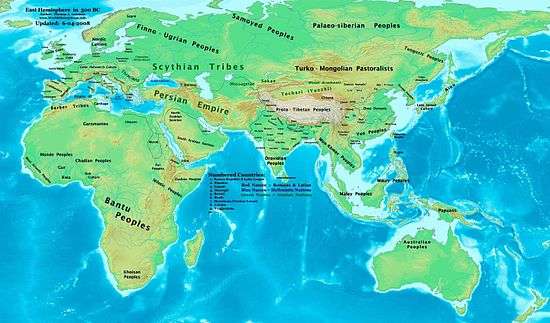
Origins
The origins of the Turkic peoples has historically been disputed, with many theories having been proposed.[33] Martine Robbeets suggests that the Turkic peoples were descended from a Transeurasian agricultural community based in northeast China, which is to be associated with the Xinglongwa culture and the succeeding Hongshan culture.[34][35] The East Asian agricultural origin of the Turkic peoples has been corroborated in multiple recent studies.[36][37] Around 2,200 BC, due to the desertification of northeast China, the agricultural ancestors of the Turkic peoples probably migrated westwards into Mongolia, where they adopted a pastoral lifestyle.[34]
Linguistic and genetic evidence strongly suggest an early presence of Turkic peoples in Mongolia.[86][33] Genetic studies have shown that the early Turkic peoples were of diverse origins, and that Turkic culture was spread westwards through language diffusion rather than migrations of a homogenous population.[39] The genetic evidence suggests that the Turkification of Central Asia was carried out by East Asian dominant minorities migrating out of Mongolia.[38]
Early historical attestation
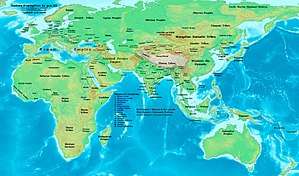
Early Turkic speakers, such as the Tiele (also known as Gaoche 高車, lit. "High Carts"),[90] may be related to Xiongnu and Dingling.[91] According to the Book of Wei, the Tiele people were the remnants of the Chidi (赤狄), the red Di people competing with the Jin in the Spring and Autumn period.[92] Historically they were established after the 6th century BCE.[93]
Historical Arab and Persian descriptions of Turks state that they looked strange from their perspective and were extremely physically different from Arabs. Turks were described as "broad faced people with small eyes".[94][95] Medieval Muslim writers noted that Tibetans and Turks resembled each other, and that they often were not able to tell the difference between Turks and Tibetans.[96] Moreover, on Western Turkic coins "the faces of the governor and governess are clearly mongoloid (a roundish face, narrow eyes), and the portrait have definite old Türk features (long hair, absence of headdress of the governor, a tricorn headdress of the governess)".[97]
Xiongnu (3rd c. BCE – 1st c. CE)
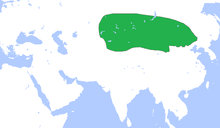
The earliest separate Turkic peoples, such as the Gekun (鬲昆) and Xinli (薪犁), appeared on the peripheries of the late Xiongnu confederation about 200 BCE[98][93] (contemporaneous with the Chinese Han Dynasty)[99] and later among the Turkic-speaking Tiele[100] as Hegu (紇骨)[101] and Xue (薛).[102][103] It has even been suggested that the Xiongnu themselves, who were mentioned in Han Dynasty records, were Proto-Turkic speakers.[104][105][106][107][108] Although little is known for certain about the Xiongnu language(s), it seems likely that at least a considerable part of Xiongnu tribes spoke a Turkic language.[109] Some scholars believe they were probably a confederation of various ethnic and linguistic groups.[110][111] A genetic research in 2003, on skeletons from a 2000 year old Xiongnu necropolis in Mongolia, found individuals with similar DNA sequences as modern Turkic groups, supporting the view that at least parts of the Xiongu were of Turkic origin.[112]
Xiongnu writing, older than Turkic, is agreed to have the earliest known Turkic alphabet, the Orkhon script. This has been argued recently using the only extant possibly Xiongu writings, the rock art of the Yinshan and Helan Mountains.[113] Petroglyphs of this region dates from the 9th millennium BCE to the 19th century, and consists mainly of engraved signs (petroglyphs) and few painted images.[114] Excavations done during 1924–1925 in Noin-Ula kurgans located in the Selenga River in the northern Mongolian hills north of Ulaanbaatar produced objects with over 20 carved characters, which were either identical or very similar to the runic letters of the Turkic Orkhon script discovered in the Orkhon Valley.[115]
Huns (4th–6th c. CE)

The Hun hordes ruled by Attila, who invaded and conquered much of Europe in the 5th century, might have been, at least partially, Turkic and descendants of the Xiongnu.[99][116][117] In the 18th century, the French scholar Joseph de Guignes became the first to propose a link between the Huns and the Xiongnu people, who were northern neighbours of China in the 3rd century BC.[118] Since Guignes' time, considerable scholarly effort has been devoted to investigating such a connection. The issue remains controversial. Their relationships to other peoples known collectively as the Iranian Huns are also disputed.
Some scholars regard the Huns as one of the earlier Turkic tribes, while others view them as Proto-Mongolian or Yeniseian in origin.[119][120] Linguistic studies by Otto Maenchen-Helfen and others have suggested that the language used by the Huns in Europe was too little documented to be classified. Nevertheless, many of the proper names used by Huns appear to be Turkic in origin.[121][122]
Turkic peoples originally used their own alphabets, like Orkhon and Yenisey runiforms, and later the Uyghur alphabet. Traditional national and cultural symbols of the Turkic peoples include wolves in Turkic mythology and tradition; as well as the color blue, iron, and fire. Turquoise blue (the word turquoise comes from the French word meaning "Turkish") is the color of the stone turquoise still used in jewelry and as a protection against the evil eye.
Steppe expansions
Göktürks – Turkic Khaganate (5th–8th c.)
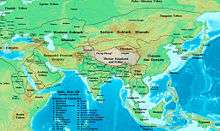
The first mention of Turks was in a Chinese text that mentioned trade between Turk tribes and the Sogdians along the Silk Road.[123] The Ashina clan migrated from Li-jien (modern Zhelai Zhai) to the Rourans seeking inclusion in their confederacy and protection from the prevalent dynasty. The Ashina tribe were famed metalsmiths and were granted land near a mountain quarry which looked like a helmet, from which they were said to have gotten their name 突厥 (tūjué), the first recorded use of "Turk" as a political name. In the 6th-century, Ashina's power had increased such that they conquered the Tiele on their Rouran overlords' behalf and even overthrew Rourans and established the First Turkic Khaganate.[124]
In the 6th century, 400 years after the collapse of northern Xiongnu power in Inner Asia, the Göktürks assumed leadership of the Turkic peoples. Formerly in the Xiongnu nomadic confederation, the Göktürks inherited their traditions and administrative experience. From 552 to 745, Göktürk leadership united the nomadic Turkic tribes into the Göktürk Empire on Mongolia and Cental Asia. The name derives from gok, "blue" or "celestial". Unlike its Xiongnu predecessor, the Göktürk Khaganate had its temporary Khagans from the Ashina clan, who were subordinate to a sovereign authority controlled by a council of tribal chiefs. The Khaganate retained elements of its original animistic- shamanistic religion, that later evolved into Tengriism, although it received missionaries of Buddhist monks and practiced a syncretic religion. The Göktürks were the first Turkic people to write Old Turkic in a runic script, the Orkhon script. The Khaganate was also the first state known as "Turk". It eventually collapsed due to a series of dynastic conflicts, but many states and peoples later used the name "Turk".[125][126]
The Göktürks (First Turkic Kaganate) quickly spread west to the Caspian Sea. Between 581 and 603 the Western Turkic Khaganate in Kazakhstan separated from the Eastern Turkic Khaganate in Mongolia and Manchuria during a civil war. The Han-Chinese successfully overthrew the Eastern Turks in 630 and created a military Protectorate until 682. After that time the Second Turkic Khaganate ruled large parts of the former Göktürk area. After several wars between Turks, Chinese and Tibetans, the weakened Second Turkic Khaganate was replaced by the Uyghur Khaganate in the year 744.[127]
Bulgars, Golden Horde and the Siberian Khanate
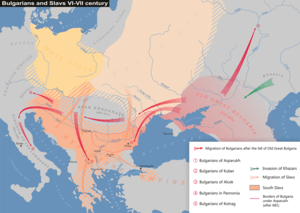
The Bulgars established themselves in between the Caspian and Black Seas in the 5th and 6th centuries, followed by their conquerors, the Khazars who converted to Judaism in the 8th or 9th century. After them came the Pechenegs who created a large confederacy, which was subsequently taken over by the Cumans and the Kipchaks. One group of Bulgars settled in the Volga region and mixed with local Volga Finns to become the Volga Bulgars in what is today Tatarstan. These Bulgars were conquered by the Mongols following their westward sweep under Genghis Khan in the 13th century. Other Bulgars settled in Southeastern Europe in the 7th and 8th centuries, and mixed with the Slavic population, adopting what eventually became the Slavic Bulgarian language. Everywhere, Turkic groups mixed with the local populations to varying degrees.[124]
The Volga Bulgaria became an Islamic state in 922 and influenced the region as it controlled many trade routes. In the 13th century, Mongols invaded Europe and established the Golden Horde in Eastern Europe, western & northern Central Asia, and even western Siberia. The Cuman-Kipchak Confederation and Islamic Volga Bulgaria were absorbed by the Golden Horde in the 13th century; in the 14th century, Islam became the official religion under Uzbeg Khan where the general population (Turks) as well as the aristocracy (Mongols) came to speak the Kipchak language and were collectively known as "Tatars" by Russians and Westerners. This country was also known as the Kipchak Khanate and covered most of what is today Ukraine, as well as the entirety of modern-day southern and eastern Russia (the European section). The Golden Horde disintegrated into several khanates and hordes in the 15th and 16th century including the Crimean Khanate, Khanate of Kazan, and Kazakh Khanate (among others), which were one by one conquered and annexed by the Russian Empire in the 16th through 19th centuries.
In Siberia, the Siberian Khanate was established in the 1490s by fleeing Tatar aristocrats of the disintegrating Golden Horde who established Islam as the official religion in western Siberia over the partly Islamized native Siberian Tatars and indigenous Uralic peoples. It was the northern-most Islamic state in recorded history and it survived up until 1598 when it was conquered by Russia.
Uyghur Khaganate (8th–9th c.)
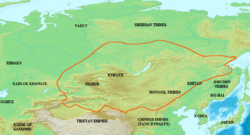
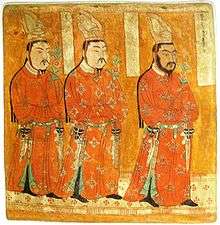
The Uyghur empire ruled large parts of Mongolia, Northern and Western China and parts of northern Manchuria. They followed largely Buddhism and animistic traditions. During the same time, the Shatuo Turks emerged as power factor in Northern and Central China and were recognized by the Tang Empire as allied power. The Uyghur empire fell after several wars in the year 840.[127][128]
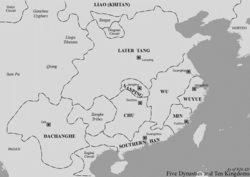
The Shatuo Turks had founded several short-lived sinicized dynasties in northern China during the Five Dynasties and Ten Kingdoms period. The official language of these dynasties was Chinese and they used Chinese titles and names. Some Shaotuo Turks emperors also claimed patrilineal Han Chinese ancestry.[129][130][131]
After the fall of the Tang-Dynasty in 907, the Shatuo Turks replaced them and created the Later Tang Dynasty in 923. The Shatuo Turks ruled over a large part of northern China, including Beijing. They adopted Chinese names and united Turkic and Chinese traditions. Later Tang fall in 937 but the Shatuo rose to become one of the most powerful clans of China. They created several other dynasies, including the Later Jin and Later Han. The Shatuo Turks were later assimilated into the Han Chinese ethnic group after they were conquered by the Song dynasty.[128][132]
The Yenisei Kyrgyz allied with China to destroy the Uyghur Khaganate in 840. The Kyrgyz people ultimately settled in the region now referred to as Kyrgyzstan.
Central Asia
Kangar union (659–750)
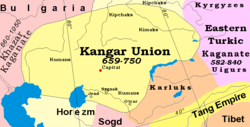
The Kangar Union (Qanghar Odaghu) was a Turkic state in the former territory of the Western Turkic Khaganate (the entire present-day state of Kazakhstan, without Zhetysu). The ethnic name Kangar is a medieval name for the Kangly people, who are now part of the Kazakh, Uzbek,[133] and Karakalpak nations. The capital of the Kangar union was located in the Ulytau mountains. The Pechenegs, three of whose tribes were known as Kangar (Greek: Καγγαρ), after being defeated by the Oghuzes, Karluks, and Kimek-Kypchaks, attacked the Bulgars and established the Pecheneg state in Eastern Europe (840–990 CE).
Oghuz Yabgu State (766–1055)
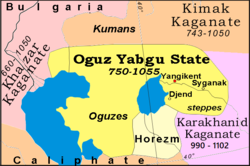
The Oguz Yabgu State (Oguz il, meaning "Oguz Land,", "Oguz Country")(750–1055) was a Turkic state, founded by Oghuz Turks in 766, located geographically in an area between the coasts of the Caspian and Aral Seas. Oguz tribes occupied a vast territory in Kazakhstan along the Irgiz, Yaik, Emba, and Uil rivers, the Aral Sea area, the Syr Darya valley, the foothills of the Karatau Mountains in Tien-Shan, and the Chui River valley (see map). The Oguz political association developed in the 9th and 10th centuries in the basin of the middle and lower course of the Syr Darya and adjoining the modern western Kazakhstan steppes.
Iranian, Indian, Arabic, and Anatolian expansion
Turkic peoples and related groups migrated west from Northeastern China, present-day Mongolia, Siberia and the Turkestan-region towards the Iranian plateau, South Asia, and Anatolia (modern Turkey) in many waves. The date of the initial expansion remains unknown.
Persia
Ghaznavid dynasty (977–1186)
The Ghaznavid dynasty (Persian: غزنویان ġaznaviyān) was a Persianate[134] Muslim dynasty of Turkic mamluk origin,[135] at their greatest extent ruling large parts of Iran, Afghanistan, much of Transoxiana and the northwest Indian subcontinent (part of Pakistan) from 977 to 1186.[136][137][138] The dynasty was founded by Sabuktigin upon his succession to rule of the region of Ghazna after the death of his father-in-law, Alp Tigin, who was a breakaway ex-general of the Samanid Empire from Balkh, north of the Hindu Kush in Greater Khorasan.[139]
Although the dynasty was of Central Asian Turkic origin, it was thoroughly Persianised in terms of language, culture, literature and habits[140][141][142][143] and hence is regarded by some as a "Persian dynasty".[144]
Seljuk Empire (1037–1194)
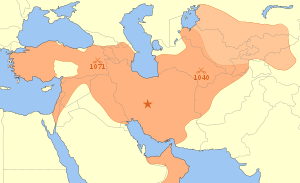
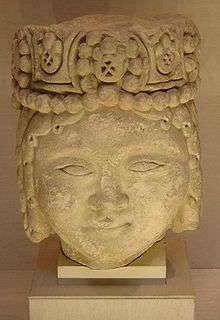
The Seljuk Empire (Persian: آل سلجوق, romanized: Āl-e Saljuq, lit. 'House of Saljuq') or the Great Seljuq Empire[145][note 1] was a high medieval Turko-Persian[148] Sunni Muslim empire, originating from the Qiniq branch of Oghuz Turks.[149] At its greatest extent, the Seljuk Empire controlled a vast area stretching from western Anatolia and the Levant to the Hindu Kush in the east, and from Central Asia to the Persian Gulf in the south.
The Seljuk empire was founded by Tughril Beg (1016–1063) and his brother Chaghri Beg (989–1060) in 1037. From their homelands near the Aral Sea, the Seljuks advanced first into Khorasan and then into mainland Persia, before eventually conquering eastern Anatolia. Here the Seljuks won the battle of Manzikert in 1071 and conquered most of Anatolia from the Byzantine Empire, which became one of the reasons for the first crusade (1095–1099). From c. 1150–1250, the Seljuk empire declined, and was invaded by the Mongols around 1260. The Mongols divided Anatolia into emirates. Eventually one of these, the Ottoman, would conquer the rest.
Timurid Empire (1370–1507)

The Timurid Empire were an Uzbek-based Turkic empire founded in the late 14th century by Timurlane, a descendant of Genghis Khan. Timur, although a self-proclaimed devout Muslim, brought great slaughter in his conquest of fellow Muslims in neighboring Islamic territory and contributed to the ultimate demise of many Muslim states, including the Golden Horde.
Safavid dynasty (1501–1736)
The Safavid dynasty of Persia (1501–1736) were of mixed ancestry (Kurdish[150] and Azerbaijani,[151] which included intermarriages with Georgian,[152] Circassian,[153][154] and Pontic Greek[155] dignitaries). Through intermarriage and other political considerations, the Safavids spoke Persian and Turkish,[156][157] and some of the Shahs composed poems in their native Turkish language. Concurrently, the Shahs themselves also supported Persian literature, poetry and art projects including the grand Shahnama of Shah Tahmasp.[158][159] The Safavid dynasty ruled parts of Greater Iran for more than two centuries.[160][161][162][163] and established the Twelver school of Shi'a Islam[164] as the official religion of their empire, marking one of the most important turning points in Muslim history
Afsharid dynasty (1736-1796)
The Afsharid dynasty was named after the Turkic Afshar tribe to which they belonged. The Afshars had migrated from Turkestan to Azerbaijan in the 13th century. The dynasty was founded in 1736 by the military commander Nader Shah who deposed the last member of the Safavid dynasty and proclaimed himself King of Iran. Nader belonged to the Qereqlu branch of the Afshars.[165] During Nader's reign, Iran reached its greatest extent since the Sassanid Empire.
South Asia
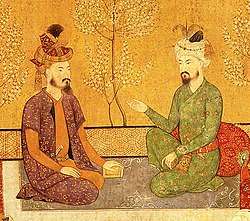
The Delhi Sultanate is a term used to cover five short-lived, Delhi-based kingdoms three of which were of Turkic origin in medieval India. These Turkic dynasties were the Mamluk dynasty (1206–90); the Khalji dynasty (1290–1320); and the Tughlaq dynasty (1320–1414). Southern India also saw many Turkic origin dynasties like the Bahmani Sultanate, the Adil Shahi dynasty, the Bidar Sultanate, and the Qutb Shahi dynasty, collectively known as the Deccan sultanates. The Mughal Empire was a Turkic-founded Indian empire that, at its greatest territorial extent, ruled most of the South Asia, including Afghanistan, Pakistan, India, Bangladesh and parts of Uzbekistan from the early 16th to the early 18th centuries. The Mughal dynasty was founded by a Chagatai Turkic prince named Babur (reigned 1526–30), who was descended from the Turkic conqueror Timur (Tamerlane) on his father's side and from Chagatai, second son of the Mongol ruler Genghis Khan, on his mother's side.[166][167] A further distinction was the attempt of the Mughals to integrate Hindus and Muslims into a united Indian state.[166][168][169][170]
Arabian world

The Arab Muslim Umayyads and Abbasids fought against the pagan Turks in the Turgesh Khaganate in the Muslim conquest of Transoxiana. The Medieval Arabs recorded that Medieval Turks looked strange from their perspective and were extremely physically different from the Arabs, calling them "broad faced people with small eyes".[94][95] Medieval Muslim writers noted that Tibetans and Turks resembled each other, and that they often were not able to tell the difference between Turks and Tibetans.[96]
Turkic soldiers in the army of the Abbasid caliphs emerged as the de facto rulers of most of the Muslim Middle East (apart from Syria and Egypt), particularly after the 10th century. The Oghuz and other tribes captured and dominated various countries under the leadership of the Seljuk dynasty and eventually captured the territories of the Abbasid dynasty and the Byzantine Empire.[124]
Anatolia – Ottomans
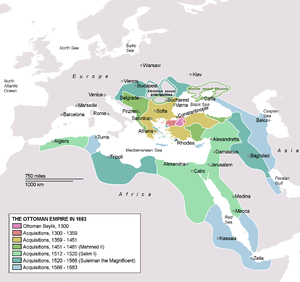
After many battles, the western Oghuz Turks established their own state and later constructed the Ottoman Empire. The main migration of the Oghuz Turks occurred in medieval times, when they spread across most of Asia and into Europe and the Middle East.[124] They also took part in the military encounters of the Crusades.[171] In 1090–91, the Turkic Pechenegs reached the walls of Constantinople, where Emperor Alexius I with the aid of the Kipchaks annihilated their army.[172]
As the Seljuk Empire declined following the Mongol invasion, the Ottoman Empire emerged as the new important Turkic state, that came to dominate not only the Middle East, but even southeastern Europe, parts of southwestern Russia, and northern Africa.[124]
Islamization
Turkic peoples like the Karluks (mainly 8th century), Uyghurs, Kyrgyz, Kazakhs, and Turkmens later came into contact with Muslims, and most of them gradually adopted Islam. Some groups of Turkic people practice other religions, including their original animistic-shamanistic religion, Christianity, Burkhanism, Jews (Khazars, Krymchaks, Crimean Karaites), Buddhism and a small number of Zoroastrians.
Modern history
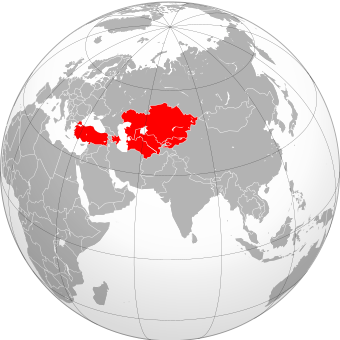
The Ottoman Empire gradually grew weaker in the face of poor administration, repeated wars with Russia, Austria and Hungary, and the emergence of nationalist movements in the Balkans, and it finally gave way after World War I to the present-day Republic of Turkey.[124] Ethnic nationalism also developed in Ottoman Empire during the 19th century, taking the form of Pan-Turkism or Turanism.
The Turkic peoples of Central Asia were not organized in nation-states during most of the 20th century, after the collapse of the Russian Empire living either in the Soviet Union or (after a short-lived First East Turkestan Republic) in the Chinese Republic.
In 1991, after the disintegration of the Soviet Union, five Turkic states gained their independence. These were Azerbaijan, Kazakhstan, Kyrgyzstan, Turkmenistan, and Uzbekistan. Other Turkic regions such as Tatarstan, Tuva, and Yakutia remained in the Russian Federation. Chinese Turkestan remained part of the People's Republic of China.
Immediately after the independence of the Turkic states, Turkey began seeking diplomatic relations with them. Over time political meetings between the Turkic countries increased and led to the establishment of TÜRKSOY in 1993 and later the Turkic Council in 2009.
International organizations
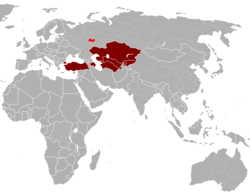
There are several international organizations created with the purpose of furthering cooperation between countries with Turkic-speaking populations, such as the Joint Administration of Turkic Arts and Culture (TÜRKSOY) and the Parliamentary Assembly of Turkic-speaking Countries (TÜRKPA) and the Turkic Council.
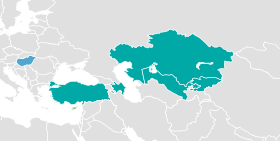
The TAKM – Organization of the Eurasian Law Enforcement Agencies with Military Status, was established on 25 January 2013. It is an intergovernmental military law enforcement (gendarmerie) organization of currently three Turkic countries (Azerbaijan, Kyrgyzstan and Turkey) and Kazakhstan as observer.
TÜRKSOY
Türksoy carries out activities to strengthen cultural ties between Turkic peoples. One of the main goals to transmit their common cultural heritage to future generations and promote it around the world.[173]
Every year, one city in the Turkic world is selected as the "Cultural Capital of the Turkic World". Within the framework of events to celebrate the Cultural Capital of the Turkic World, numerous cultural events are held, gathering artists, scholars and intellectuals, giving them the opportunity to exchange their experiences, as well as promoting the city in question internationally.[174]
Turkic Council
The newly established Turkic Council, founded on November 3, 2009 by the Nakhchivan Agreement confederation, Kazakhstan, Kyrgyzstan and Turkey, aims to integrate these organizations into a tighter geopolitical framework.
The member countries are Azerbaijan, Kazakhstan, Kyrgyzstan, and Turkey. Uzbekistan formally applied for membership on September 12, 2019.[175] The idea of setting up this cooperative council was first put forward by Kazakh President Nursultan Nazarbayev back in 2006. Turkmenistan is currently not an official member of the council, however, it is a possible future member of the council.[176] Hungary has announced to be interested in joining the Turkic council. Since August 2018, Hungary has official observer status in the Turkic Council.[177]
Demographics

The distribution of people of Turkic cultural background ranges from Siberia, across Central Asia, to Southern Europe. As of 2011 the largest groups of Turkic people live throughout Central Asia—Kazakhstan, Kyrgyzstan, Turkmenistan, Uzbekistan, and Azerbaijan, in addition to Turkey and Iran. Additionally, Turkic people are found within Crimea, Altishahr region of western China, northern Iraq, Israel, Russia, Afghanistan, and the Balkans: Moldova, Bulgaria, Romania, and former Yugoslavia. A small number of Turkic people also live in Vilnius, the capital of Lithuania. Small numbers inhabit eastern Poland and the south-eastern part of Finland.[178] There are also considerable populations of Turkic people (originating mostly from Turkey) in Germany, United States, and Australia, largely because of migrations during the 20th century.
Sometimes ethnographers group Turkic people into six branches: the Oghuz Turks, Kipchak, Karluk, Siberian, Chuvash, and Sakha/Yakut branches. The Oghuz have been termed Western Turks, while the remaining five, in such a classificatory scheme, are called Eastern Turks.
The genetic distances between the different populations of Uzbeks scattered across Uzbekistan is no greater than the distance between many of them and the Karakalpaks. This suggests that Karakalpaks and Uzbeks have very similar origins. The Karakalpaks have a somewhat greater bias towards the eastern markers than the Uzbeks.[179]
Historical population:
| Year | Population |
|---|---|
| 1 AD | 2–2.5 million? |
| 2013 | 150–200 million |
The following incomplete list of Turkic people shows the respective groups' core areas of settlement and their estimated sizes (in millions):
| People | Primary homeland | Population | Modern language | Predominant religion and sect |
|---|---|---|---|---|
| Turks | Turkey | 70 M | Turkish | Sunni Islam |
| Azerbaijanis | Iranian Azerbaijan, Republic of Azerbaijan | 30–35 M | Azerbaijani | Shia Islam (65%), Sunni Islam (35%)[180][181] (Hanafi). |
| Uzbeks | Uzbekistan | 28.3 M | Uzbek | Sunni Islam |
| Kazakhs | Kazakhstan | 13.8 M | Kazakh | Sunni Islam |
| Uyghurs | Altishahr (China) | 9 M | Uyghur | Sunni Islam |
| Turkmens | Turkmenistan | 8 M | Turkmen | Sunni Islam |
| Tatars | Tatarstan (Russia) | 7 M | Tatar | Sunni Islam |
| Kyrgyzs | Kyrgyzstan | 4.5 M | Kyrgyz | Sunni Islam |
| Bashkirs | Bashkortostan (Russia) | 2 M | Bashkir | Sunni Islam |
| Crimean Tatars | Crimea (Russia/Ukraine) | 0.5 to 2 M | Crimean Tatar | Sunni Islam |
| Qashqai | Southern Iran (Iran) | 0.9 M | Qashqai | Shia Islam |
| Chuvashes | Chuvashia (Russia) | 1.7 M | Chuvash | Orthodox Christianity |
| Karakalpaks | Karakalpakstan (Uzbekistan) | 0.6 M | Karakalpak | Sunni Islam |
| Yakuts | Yakutia (Russia) | 0.5 M | Sakha | Orthodox Christianity |
| Kumyks | Dagestan (Russia) | 0.4 M | Kumyk | Sunni Islam |
| Karachays and Balkars | Karachay-Cherkessia and Kabardino-Balkaria (Russia) | 0.4 M | Karachay-Balkar | Sunni Islam |
| Tuvans | Tuva (Russia) | 0.3 M | Tuvan | Tibetan Buddhism |
| Gagauzs | Gagauzia (Moldova) | 0.2 M | Gagauz | Orthodox Christianity |
| Turkic Karaites and Krymchaks | Ukraine | 0.2 M | Karaim and Krymchak | Judaism |
Cuisine
Markets in the steppe region had a limited range of foodstuffs available—mostly grains, dried fruits, spices, and tea. Turks mostly herded sheep, goats and horses. Dairy was a staple of the nomadic diet and there are many Turkic words for various dairy products such as süt (milk), yagh (butter), ayran, qaymaq (similar to clotted cream), qi̅mi̅z (fermented mare's milk) and qurut (dried yoghurt). During the Middle Ages Kazakh, Kyrgyz and Tatars, who were historically part of the Turkic nomadic group known as the Golden Horde, continued to develop new variations of dairy products.[182]
Nomadic Turks cooked their meals in a qazan, a pot similar to a cauldron; a wooden rack called a qasqan can be used to prepare certain steamed foods, like the traditional meat dumplings called manti. They also used a saj, a griddle that was traditionally placed on stones over a fire, and shish. In later times, the Persian tava was borrowed from the Persians for frying, but traditionally nomadic Turks did most of their cooking using the qazan, saj and shish. Meals were served in a bowl, called a chanaq, and eaten with a knife (bïchaq) and spoon (qashi̅q). Both bowl and spoon were historically made from wood. Other traditional utensils used in food preparation included a thin rolling pin called oqlaghu, a colander called süzgu̅çh, and a grinding stone called tāgirmān.[182]
Medieval grain dishes included preparations of whole grains, soups, porridges, breads and pastries. Fried or toasted whole grains were called qawïrmach, while köchä was crushed grain that was cooked with dairy products. Salma were broad noodles that could be served with boiled or roasted meat; cut noodles were called tutmaj in the Middle Ages and are called kesme today.[182]
There are many types of bread doughs in Turkic cuisine. Yupqa is the thinnest type of dough, bawi̅rsaq is a type of fried bread dough, and chälpäk is a deep fried flat bread. Qatlama is a fried bread that may be sprinkled with dried fruit or meat, rolled, and sliced like pinwheel sandwiches. Toqach and chöräk are varieties of bread, and böräk is a type of filled pie pastry.[182]
Herd animals were usually slaughtered during the winter months and various types of sausages were prepared to preserve the meats, including a type of sausage called sujuk. Though prohibited by Islamic dietary restrictions, historically Turkic nomads also had a variety of blood sausage. One type of sausage, called qazi̅, was made from horsemeat and another variety was filled with a mixture of ground meat, offal and rice. Chopped meat was called qïyma and spit-roasted meat was söklünch—from the root sök- meaning "to tear off", the latter dish is known as kebab in modern times. Qawirma is a typical fried meat dish, and kullama is a soup of noodles and lamb.[182]
Religion
Early Turkic mythology and Tengrism
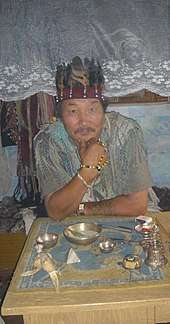
Pre-Islamic Turkic mythology was dominated by Shamanism, Animism and Tengrism. The Turkic animistic traditions were mostly focused on ancestor worship, polytheistic-animism and shamanism. Later this animistic tradition would form the more organized Tengrism.[183] The chief deity was Tengri, a sky god, worshipped by the upper classes of early Turkic society until Manichaeism was introduced as the official religion of the Uyghur Empire in 763.
The wolf symbolizes honour and is also considered the mother of most Turkic peoples. Asena (Ashina Tuwu) is the wolf mother of Tumen Il-Qağan, the first Khan of the Göktürks. The horse and predatory birds, such as the eagle or falcon, are also main figures of Turkic mythology.
Religious conversions
Buddhism
Tengri Bögü Khan made the now extinct Manichaeism the state religion of Uyghur Khaganate in 763 and it was also popular in Karluks. It was gradually replaced by the Mahayana Buddhism. It existed in the Buddhist Uyghur Gaochang up to the 12th century.[184]
Tibetan Buddhism, or Vajrayana was the main religion after Manichaeism.[185] They worshipped Täŋri Täŋrisi Burxan,[186] Quanšï Im Pusar[187] and Maitri Burxan.[188] Turkic Muslim conquest in the Indian subcontinent and west Xinjiang attributed with a rapid and almost total disappearance of it and other religions in North India and Central Asia. The Sari Uygurs "Yellow Yughurs" of Western China, as well as the Tuvans and Altai of Russia are the only remaining Buddhist Turkic peoples.
Islam
Most Turkic people today are Sunni Muslims, although a significant number in Turkey are Alevis. Alevi Turks, who were once primarily dwelling in eastern Anatolia, are today concentrated in major urban centers in western Turkey with the increased urbanism. Azeris are traditionally Shiite Muslims. Religious observance is less stricter in the Republic of Azerbaijan compared to Iranian Azerbaijan.
The major Christian-Turkic peoples are the Chuvash of Chuvashia and the Gagauz (Gökoğuz) of Moldova. The traditional religion of the Chuvash of Russia, while containing many ancient Turkic concepts, also shares some elements with Zoroastrianism, Khazar Judaism, and Islam. The Chuvash converted to Eastern Orthodox Christianity for the most part in the second half of the 19th century. As a result, festivals and rites were made to coincide with Orthodox feasts, and Christian rites replaced their traditional counterparts. A minority of the Chuvash still profess their traditional faith.[189] Church of the East was popular among Turks such as the Naimans.[190] It even revived in Gaochang and expanded in Xinjiang in the Yuan dynasty period.[191][192][193] It disappeared after its collapse.[194][195]
Today there are several groups that support a revival of the ancient traditions. Especially after the collapse of the Soviet Union, many in Central Asia converted or openly practice animistic and shamanistic rituals. It is estimated that about 60% of Kyrgyz people practice a form of animistic rituals. In Kazakhstan there are about 54.000 followers of the ancient traditions.[196][197]
Muslim Turks and non-Muslim Turks
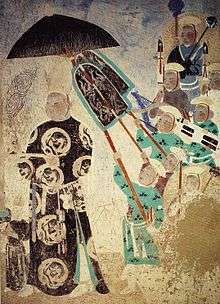
Kara-Khanids performed a mass conversion campaign against the Buddhist Uyghur Turks during the Islamization and Turkification of Xinjiang.
The non-Muslim Turks worship of Tengri and other gods was mocked and insulted by the Muslim Turk Mahmud al-Kashgari, who wrote a verse referring to them – The Infidels – May God destroy them![198][199]
The Basmil, Yabāḳu and Uyghur states were among the Turkic peoples who fought against the Kara-Khanids spread of Islam. The Islamic Kara-Khanids were made out of Tukhai, Yaghma, Çiğil and Karluk.[200]
Kashgari claimed that the Prophet assisted in a miraculous event where 700,000 Yabāqu infidels were defeated by 40,000 Muslims led by Arslān Tegīn claiming that fires shot sparks from gates located on a green mountain towards the Yabāqu.[201] The Yabaqu were a Turkic people.[202]
Mahmud al-Kashgari insulted the Uyghur Buddhists as "Uighur dogs" and called them "Tats", which referred to the "Uighur infidels" according to the Tuxsi and Taghma, while other Turks called Persians "tat".[203][204] While Kashgari displayed a different attitude towards the Turks diviners beliefs and "national customs", he expressed towards Buddhism a hatred in his Diwan where he wrote the verse cycle on the war against Uighur Buddhists. Buddhist origin words like toyin (a cleric or priest) and Burxān or Furxan (meaning Buddha, acquiring the generic meaning of "idol" in the Turkic language of Kashgari) had negative connotations to Muslim Turks.[205][199]
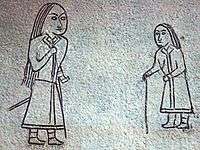
Old sports
The Kyz kuu (chase the girl) – it has been played by Turkic people at festivals since time immemorial.[206]
The Jereed – Horses have been essential and even sacred animals for Turks living as nomadic tribes in the Central Asian steppes. Turks were born, grew up, lived, fought and died on horseback. So became jereed the most important sporting and ceremonial game of Turkish people.[207]
The kokpar began with the nomadic Turkic peoples who have come from farther north and east spreading westward from China and Mongolia between the 10th and 15th centuries.[208]
The jigit which is used in the Caucasus and Central Asia to describe a skillful and brave equestrian, or a brave person in general.[209]
Gallery
Bezeklik caves and Mogao grottoes
Images of Buddhist and Manichean Turkic Uyghurs from the Bezeklik caves and Mogao grottoes.
 Uyghur king from Turfan, from the murals at the Dunhuang Mogao Caves.
Uyghur king from Turfan, from the murals at the Dunhuang Mogao Caves. Uyghur prince from the Bezeklik murals.
Uyghur prince from the Bezeklik murals.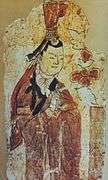 Uyghur woman from the Bezeklik murals.
Uyghur woman from the Bezeklik murals. Uyghur Princess.
Uyghur Princess.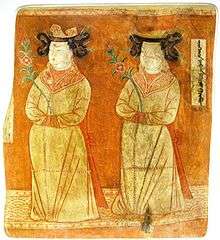 Uyghur Princesses from the Bezeklik murals.
Uyghur Princesses from the Bezeklik murals. Uyghur Princes from the Bezeklik murals.
Uyghur Princes from the Bezeklik murals. Uyghur Prince from the Bezeklik murals.
Uyghur Prince from the Bezeklik murals.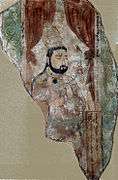 Uyghur noble from the Bezeklik murals.
Uyghur noble from the Bezeklik murals..jpg) Uyghur Manichaean Elect depicted on a temple banner from Qocho.
Uyghur Manichaean Elect depicted on a temple banner from Qocho. Uyghur donor from the Bezeklik murals.
Uyghur donor from the Bezeklik murals.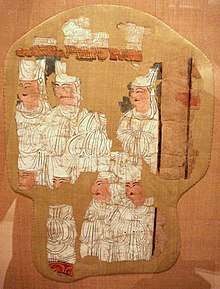 Uyghur Manichaean Electae from Qocho.
Uyghur Manichaean Electae from Qocho.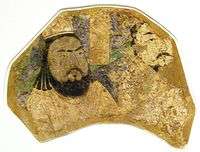 Uyghur Manichaean clergymen from Qocho.
Uyghur Manichaean clergymen from Qocho.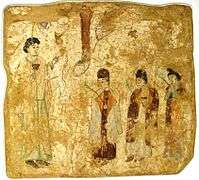
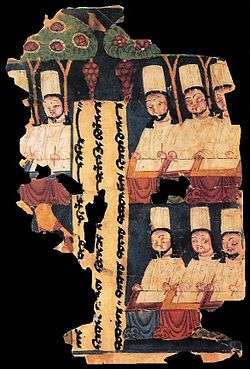 Manicheans from Qocho
Manicheans from Qocho
Medieval times
Modern times
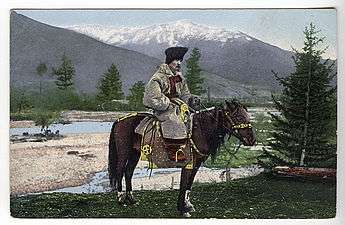 Altai man in national suit on horseback.
Altai man in national suit on horseback.- Azerbaijani girls in traditional dress.
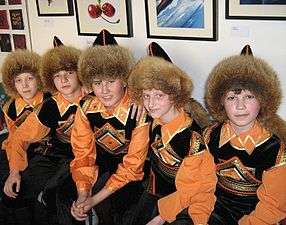 Bashkir boys in national dress.
Bashkir boys in national dress.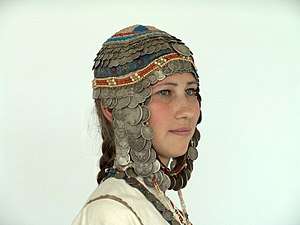 A Chuvash woman in traditional dress.
A Chuvash woman in traditional dress.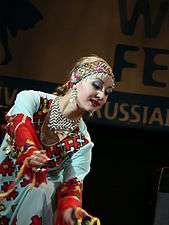 A female Chuvash dancer in traditional dress.
A female Chuvash dancer in traditional dress. Young and old Gagauz people.
Young and old Gagauz people. Karachay patriarchs in the 19th century.
Karachay patriarchs in the 19th century.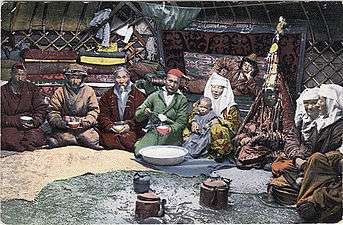
- Khakas people with traditional instruments.
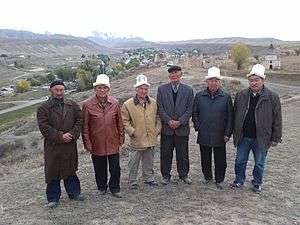 Kyrgyz elders in On-Archa, Kyrgyzstan.
Kyrgyz elders in On-Archa, Kyrgyzstan..jpg)
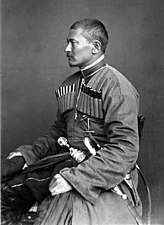 Nogai man in national costume.
Nogai man in national costume. U.S. Secretary of State Hillary Clinton visits Tatarstan.
U.S. Secretary of State Hillary Clinton visits Tatarstan.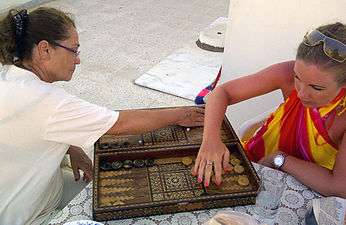 Turkish women playing backgammon.
Turkish women playing backgammon.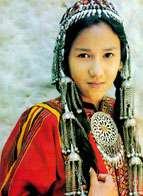 Turkmen girl in national dress.
Turkmen girl in national dress.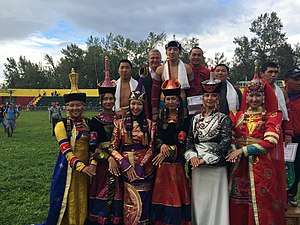
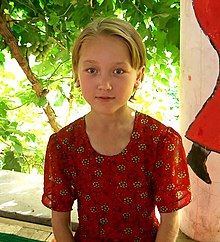 An Uyghur girl - a natural blond with epicanthic fold in Xinjiang, China.
An Uyghur girl - a natural blond with epicanthic fold in Xinjiang, China.
See also
- Por-Bazhyn
- Ordu-Baliq
- Jankent
- Dukha people
- Pan-Turkism
- Turkic languages
- Turkic migrations
- Turkic mythology
- Turko-Persian tradition
- Turko-Mongol
- Turkology
- List of Turkic dynasties and countries
Notes
- In order to distinguish from the Anatolian branch of the family, the Sultanate of Rum.[146][147]
References
- Brigitte Moser, Michael Wilhelm Weithmann, Landeskunde Türkei: Geschichte, Gesellschaft und Kultur, Buske Publishing, 2008, p. 173
- Deutsches Orient-Institut, Orient, Vol. 41, Alfred Röper Publushing, 2000, p. 611
- Yunusbayev et al. 2015.
- "Turkey". The World Factbook. Retrieved 21 December 2014. "Population: 81,619,392 (July 2014 est.)" "Ethnic groups: Turkish 70–75%, Kurdish 18%, other minorities 7–12% (2008 est.)" 70% of 81.6m = 57.1m, 75% of 81.6m = 61.2m
- "Uzbekistan". The World Factbook. Retrieved 21 December 2014. "Population: 28,929,716 (July 2014 est.)" "Ethnic groups: Uzbek 80%, Russian 5.5%, Tajik 5%, Kazakh 3%, Karakalpak 2.5%, Tatar 1.5%, other 2.5% (1996 est.)" Assuming Uzbek, Kazakh, Karakalpak and Tartar are included as Turks, 80% + 3% + 2.5% + 1.5% = 87%. 87% of 28.9m = 25.2m
- "Azerbaijani (people)". Encyclopædia Britannica. Retrieved 24 January 2012. (15 million)
- Egbert Jahn, (2009). Nationalism in Late and Post-Communist Europe, p. 293 (20 mil)
- Library of Congress - Federal Research Division - Country Profile: Iran, May 2008, page 5
- "Kazakhstan". The World Factbook. Retrieved 21 December 2014. "Population: 17,948,816 (July 2014 est.)" "Ethnic groups: Kazakh (Qazaq) 63.1%, Russian 23.7%, Uzbek 2.9%, Ukrainian 2.1%, Uighur 1.4%, Tatar 1.3%, German 1.1%, other 4.4% (2009 est.)" Assuming Kazakh, Uzbek, Uighur and Tatar are included as Turks, 63.1% + 2.9% + 1.4% + 1.3% = 68.7%. 68.7% of 17.9m = 12.3m
- "China". The World Factbook. Retrieved 13 May 2014.
- "Azerbaijan". The World Factbook. Retrieved 30 July 2016. "Population: 9,780,780 (July 2015 est.)"
- "Turkmenistan". The World Factbook. Retrieved 13 May 2014.
- "Kyrgyzstan". The World Factbook. Retrieved 13 May 2014.
- "Afghanistan". The World Factbook. Retrieved 13 May 2014.
- Triana, María (2017), Managing Diversity in Organizations: A Global Perspective, Taylor & Francis, p. 168, ISBN 978-1-317-42368-3,
Turkmen, Iraqi citizens of Turkish origin, are the third largest ethnic group in Iraq after Arabs and Kurds and they are said to number about 3 million of Iraq's 34.7 million citizens according to the Iraqi Ministry of Planning.
- Bassem, Wassim (2016). "Iraq's Turkmens call for independent province". Al-Monitor. Archived from the original on 17 October 2016.
Turkmens are a mix of Sunnis and Shiites and are the third-largest ethnicity in Iraq after Arabs and Kurds, numbering about 3 million out of the total population of about 34.7 million, according to 2013 data from the Iraqi Ministry of Planning.
- "Tajikistan". The World Factbook. Retrieved 13 May 2014.
- "Obama, recognize us". St. Louis American. Retrieved 18 March 2015.
- Nahost-Informationsdienst (ISSN 0949-1856): Presseausschnitte zu Politik, Wirtschaft und Gesellschaft in Nordafrika und dem Nahen und Mittleren Osten. Autors: Deutsches Orient–Institut; Deutsches Übersee–Institut. Hamburg: Deutsches Orient–Institut, 1996, seite 33.
The number of Turkmens in Syria is not fully known, with unconfirmed estimates ranging between 800,000 and one million.
- National Statistical Institute of Bulgaria (2011). "2011 Population Census in the Republic of Bulgaria (Final data)" (PDF). National Statistical Institute of Bulgaria.
- "All-Ukrainian population census 2001 – General results of the census – National composition of population". State Statistics Committee of Ukraine. 2003. Retrieved 2 September 2017.
- TRNC SPO, Economic and Social Indicators 2014, pages=2–3
- "Mongolia". The World Factbook. Retrieved 13 May 2014.
- Al-Akhbar. "Lebanese Turks Seek Political and Social Recognition". Archived from the original on 20 June 2018. Retrieved 2 March 2012.
- "Tension adds to existing wounds in Lebanon". Today's Zaman. Archived from the original on 11 January 2012. Retrieved 6 April 2011.
- Ahmed, Yusra (2015), Syrian Turkmen refugees face double suffering in Lebanon, Zaman Al Wasl, retrieved 11 October 2016
- Syrian Observer (2015). "Syria's Turkmen Refugees Face Cruel Reality in Lebanon". Retrieved 10 October 2016.
- "North Macedonia". The World Factbook. Retrieved 13 May 2014.
- Encyclopedia Britannica. Turkic peoples. "Turkic peoples, any of various peoples whose members speak languages belonging to the Turkic subfamily..."
- Yunusbayev et al. 2015, p. 1. "The Turkic peoples represent a diverse collection of ethnic groups defined by the Turkic languages."
- Yunusbayev et al. 2015, pp. 1-2.
- Robbeets 2017, pp. 216-218.
- Robbeets 2020.
- Nelson et al. 2020.
- Li et al. 2020.
- Damgaard et al. 2018, pp. 4-5. "These results suggest that Turkic cultural customs were imposed by an East Asian minority elite onto central steppe nomad populations... The wide distribution of the Turkic languages from Northwest China, Mongolia and Siberia in the east to Turkey and Bulgaria in the west implies large-scale migrations out of the homeland in Mongolia.
- Lee & Kuang 2017, p. 197. "Both Chinese histories and modern dna studies indicate that the early and medieval Turkic peoples were made up of heterogeneous populations. The Turkicisation of central and western Eurasia was not the product of migrations involving a homogeneous entity, but that of language diffusion."
- Tarihte Türk devletleri, Volume 1. Ankara Üniversitesi Basımevi, 1987. p. 1.
- Moše Weinfeld. Social Justice in Ancient Israel and in the Ancient Near East. 1995. p. 66: "For the concept of durgu | duruggu and its connection to piY (in its meaning "origin"), see H. Tadmor, (above n. 25), p. 28"
- Kultegin's Memorial Complex, TÜRIK BITIG Orkhon inscriptions
- Tonyukuk's Memorial Complex, TÜRIK BITIG Bain Tsokto inscriptions
- "Encyclopedia of the Peoples of Asia and Oceania, p. 826". Retrieved 24 June 2020.
- "新亞研究所 – 典籍資料庫". Archived from the original on 21 February 2014. Retrieved 18 March 2015.
- Moriyasu & Ochir 1999, p. 123
- The Turkmen Archived 2011-03-18 at the Wayback Machine
- Pliny, Natural History – Harvard University Press, vol. II (Libri III-VII); reprinted 1961, p. 351
- Pomponius Mela's Description of the World, Pomponius Mela, University of Michigan Press, 1998, p. 67
- Prof. Dr. Ercümend Kuran, Türk Adı ve Türklük Kavramı, Türk Kültürü Dergisi, Yıl, XV, S. 174, Nisan 1977. s. 18–20.
- Peter B. Golden, Introduction to the History of the Turkic People, p. 12: "... source (Herod.IV.22) and other authors of antiquity, Togarma of the Old Testament, Turukha/Turuska of Indic sources, Turukku of Assyrian..."
- German Archaeological Institute. Department Teheran, Archaeologische Mitteilungen aus Iran, Vol. 19, Dietrich Reimer, 1986, p. 90
- Golden, Peter B. "Some Thoughts on the Origins of the Turks and the Shaping of the Turkic Peoples". (2006) In: Contact and Exchange in the Ancient World. Ed. Victor H. Mair. University of Hawai'i Press. p. 143: "Subsequently, "Türk" would find a suitable Turkic etymology, being conflated with the word türk, which means one in the prime of youth, powerful, mighty (Rona-Tas 1991,10–13)."
- (Bŭlgarska akademii︠a︡ na naukite. Otdelenie za ezikoznanie/ izkustvoznanie/ literatura, Linguistique balkanique, Vol. 27–28, 1984, p. 17
- “Türk” in Turkish Etymological Dictionary, Sevan Nişanyan.
- Faruk Suümer, Oghuzes (Turkmens): History, Tribal organization, Sagas, Turkish World Research Foundation, 1992, p. 16)
- American Heritage Dictionary (2000). "The American Heritage Dictionary of the English Language: Fourth Edition – "Turk"". bartleby.com. Retrieved 2006-12-07.
- “türe-” in Turkish Etymological Dictionary, Sevan Nişanyan.
- “*töre-” in Sergei Starostin, Vladimir Dybo, Oleg Mudrak (2003), Etymological Dictionary of the Altaic Languages, Leiden: Brill Academic Publishers.
- T. Allsen, P. B. Golden, R. K. Kovalev, and A. P. Martinez (2012), ARCHIVUM EURASIAEMEDII AEV, p. 85
- Clauson, G. An Etymological Dictionary of Pre-13th Century Turkish (1972). p. 542-543
- The Peoples of the Steppe Frontier in Early Chinese Sources, Edwin G. Pulleyblank, page 35
- Studies on the Peoples and Cultures of the Eurasian Steppes, Peter B. Golden, page 27, https://www.academia.edu/9609971/Studies_on_the_Peoples_and_Cultures_of_the_Eurasian_Steppes
- Sinor, Cambridge History of Early Inner Asia, Page 295
- Golden, Peter B. "Türks and Iranians: Aspects of Türk and Khazaro-Iranian Interaction". Turcologica (105): 25.
- G. Moravcsik, Byzantinoturcica II, p. 236–39
- Jean-Paul Roux, Historie des Turks – Deux mille ans du Pacifique á la Méditerranée. Librairie Arthème Fayard, 2000.
- Merkits were always counted as a part of the Mongols within the Mongol Empire, however, some scholars proposed additional Turkic ancestry for Merkits; see also: Christopher P. Atwood – Encyclopedia of Mongolia and the Mongol Empire ISBN 9780816046713, Facts on File, Inc. 2004.
- Encyclopedia Britannica. Turkic peoples.
- Pritsak O. & Golb. N: Khazarian Hebrew Documents of the Tenth Century, Ithaca: Cornell Univ. Press, 1982.
- "Timur Archived 2013-09-22 at the Wayback Machine", The Columbia Encyclopedia, Sixth Edition, 2001–05, Columbia University Press.
- Encyclopædia Britannica article: Consolidation & expansion of the Indo-Timurids, Online Edition, 2007.
- Walton, Linda (2013). World History: Journeys from Past to Present. p. 210.
- Peter Benjamin Golden, (1992), An Introduction to the History of the Turkic Peoples, p. 110
-
- Pulleyblank, Edwin G. (2000). "Ji 姬 and Jiang 姜: The Role of Exogamic Clans in the Organization of the Zhou Polity", Early China. p. 20
- Wei Shou. Book of Wei. Vol. 1
- Tseng, Chin Yin (2012). The Making of the Tuoba Northern Wei: Constructing Material Cultural Expressions in the Northern Wei Pingcheng Period (398-494 CE) (PhD). University of Oxford. p. 1.
- Wei Shou. Book of Wei. vol. 91 "蠕蠕,東胡之苗裔也,姓郁久閭氏。" tr. "Rúrú, offsprings of Dōnghú, surnamed Yùjiŭlǘ"
- Book of Song. vol 95. "芮芮一號大檀,又號檀檀,亦匈奴別種" tr. "Ruìruì, one appellation is Dàtán, also called Tántán, likewise a Xiōngnú splinter race"
- Lee, Joo-Yup (2016). "The Historical Meaning of the Term Turk and the Nature of the Turkic Identity of the Chinggisid and Timurid Elites in Post-Mongol Central Asia". Central Asiatic Journal 59(1-2): 105.
- Turkic Language family tree entries provide the information on the Turkic-speaking populations and regions.
- Katzner, Kenneth (March 2002). Languages of the World, Third Edition. Routledge, an imprint of Taylor & Francis Books Ltd. ISBN 978-0-415-25004-7.
- Vasiliev D.D. Graphical fund of Turkic runiform writing monuments in Asian areal, М., 1983, p. 44
- Tekin 1993, p. 1
- Turkic peoples, Encyclopædia Britannica, Online Academic Edition, 2008
- Janhunen 2003, pp. 203-204.
- Robbeets 2017, p. 219.
- "Türkiye'deki Kürtlerin sayısı!" [The number of Kurds in Turkey!]. Milliyet (in Turkish). 6 June 2008. Retrieved 16 November 2016.
- Across Central Asia, a New Bond Grows – Iron Curtain's Fall Has Spawned a Convergence for Descendants of Turkic Nomad Hordes
- Pulleyblank, Edwin G. (1991). "The "High Carts": A Turkish-Speaking People before the Türks". Asia Major, THIRD SERIES, Vol. 3, No. 1. Academia Sinica: 21–22.
- Weishu, vol. 103 "高車,蓋古赤狄之餘種也,初號為狄歷,北方以為勑勒,諸夏以為高車、丁零。其語略與匈奴同而時有小異,或云其先匈奴之甥也" tr. "The Gaoche are probably remnants of the ancient Red Di. Initially they had been called Dili. Northerners consider them to be Chile. Chinese consider them to be Gaoche Dingling. Their language, in brief, and Xiongnu [language] are the same yet occasionally there are small differences. Or one may say that they are the junior relatives [lit. sisters' sons ~ sons-in-law] of the Xiongnu in former times."
- "丁零—铁勒的西迁及其所建西域政权". Archived from the original on 15 July 2015. Retrieved 18 March 2015.
- Peter Zieme: The Old Turkish Empires in Mongolia. In: Genghis Khan and his heirs. The Empire of the Mongols. Special tape for Exhibition 2005/2006, p. 64
- The Turks of the Eurasian Steppes in Medieval Arabic Writing, R. Amitai, M. Biran, eds., Mongols, Turks and Others: Eurasian Nomads and the Sedentary World. Leyde, Brill, 2005, pp. 222–3.
- Reuven Amitai; Michal Biran (2005). Mongols, Turks, and Others: Eurasian Nomads and the Sedentary World. Brill. p. 222. ISBN 978-90-04-14096-7.
- André Wink (2002). Al-Hind: The Slavic Kings and the Islamic conquest, 11th–13th centuries. BRILL. pp. 69–. ISBN 978-0-391-04174-5.
- Babayar, Gaybulla (2013). "The Imperial Titles on the Coins of the Western Turkic Qaghanate". History of Central Asia in Modern Medieval Studies. Tashkent: Yangi Nashr: 331.
- Sima Qian Records of the Grand Historian Vol. 110 "後北服渾庾、屈射、丁零、鬲昆、薪犁之國。於是匈奴貴人大臣皆服,以冒頓單于爲賢。" tr. "Later [he went] north [and] subjugated the nations of Hunyu, Qushe, Dingling, Gekun, and Xinli. Therefore, the Xiongnu nobles and dignitaries all admired [and] regarded Modun chanyu as capable"
- Findley (2005), p. 29.
- Suishu, vol. 84
- Pulleyblank, E. G. "The Name of the Kirghiz." Central Asiatic Journal 34, no. 1/2 (1990). p. 99
- Pulleyblank, "Central Asia and Non-Chinese Peoples of Ancient China", p. VII 21-26.
- Duan, "Dingling, Gaoju and Tiele", p. 370.
- Silk-Road:Xiongnu
- "Yeni Turkiye Research and Publishing Center". Retrieved 18 March 2015.
- "An Introduction to the Turkic Tribes". Retrieved 18 March 2015.
- "Early Turkish History". Archived from the original on October 27, 2009. Retrieved 2015-02-05.
- "An outline of Turkish History until 1923". Archived from the original on 12 October 2007. Retrieved 18 March 2015.
- Lebedynsky (2006), p. 59.
- Nicola di Cosmo, Ancient China and its Enemies, S. 163ff.
- Ebrey, Patricia Buckley (2010). The Cambridge Illustrated History of China (2nd ed.). Cambridge University Press. p. 69. ISBN 978-0-521-12433-1.
- Keyser-Tracqui C.; Crubezy E.; Ludes B. (2003). "Nuclear and mitochondrial DNA analysis of a 2,000-year-old necropolis in the Egyin Gol Valley of Mongolia". American Journal of Human Genetics. 73 (2): 247–260. doi:10.1086/377005. PMC 1180365. PMID 12858290.
- MA Li-qing On the new evidence on Xiongnu's writings. Archived 2007-10-19 at the Wayback Machine(Wanfang Data: Digital Periodicals, 2004)
- Paola Demattè Writing the Landscape: the Petroglyphs of Inner Mongolia and Ningxia Province (China). (Paper presented at the First International Conference of Eurasian Archaeology, University of Chicago, 3–4 May 2002.)
- N. Ishjatms, "Nomads In Eastern Central Asia", in the "History of civilizations of Central Asia", Volume 2, Fig 6, p. 166, UNESCO Publishing, 1996, ISBN 92-3-102846-4
- Ulrich Theobald. "Chinese History – Xiongnu 匈奴 (www.chinaknowledge.de)". Retrieved 18 March 2015.
- G. Pulleyblank, "The Consonantal System of Old Chinese: Part II", Asia Major n.s. 9 (1963) 206–65
- de la Vaissière 2015, p. 175, 180.
- "The Origins of the Huns". Retrieved 18 March 2015.
- VAJDA, Edward J. (2008). "Yeniseic" a chapter in the book Language isolates and microfamilies of Asia, Routledge, to be co-authored with Bernard Comrie; 53 pages).
- Otto J. Maenchen-Helfen. The World of the Huns: Studies in Their History and Culture. University of California Press, 1973
- "Otto Maenchen-Helfen, Language of Huns". Retrieved 18 March 2015.
- "Etienne de la Vaissiere", Encyclopædia Iranica article:Sogdian Trade Archived 2009-12-20 at the Wayback Machine, 1 December 2004.
- Carter V. Findley, The Turks in World History (Oxford University Press, October 2004) ISBN 0-19-517726-6
- Türk Tarih Kongresi (in Turkish). Türk Tarih Kurumu. 1999.
- West, Barbara A. (2010-05-19). Encyclopedia of the Peoples of Asia and Oceania. Infobase Publishing. p. 829. ISBN 978-1-4381-1913-7. "The first people to use the ethnonym Turk to refer to themselves were the Turuk people of the Gokturk Khanate in the mid sixth-century"
- Haywood, John (1998), Historical Atlas of the Medieval World, AD 600–1492, Barnes & Noble
- Theobald, Ulrich. "Shatuo Türks 沙陀突厥 (www.chinaknowledge.de)". www.chinaknowledge.de. Retrieved 2019-04-30.
- Wudai Shi, ch. 75. Considering the father was originally called Nieliji without a surname, the fact that his patrilineal ancestors all had Chinese names here indicates that these names were probably all created posthumously after Shi Jingtang became a "Chinese" emperor. Shi Jingtang actually claimed to be a descendant of Chinese historical figures Shi Que and Shi Fen, and insisted that his ancestors went westwards towards non-Han Chinese area during the political chaos at the end of the Han Dynasty in the early 3rd century.
- According to Old History of the Five Dynasties, vol. 99, and New History of the Five Dynasties, vol. 10. Liu Zhiyuan was of Shatuo origin. According to Wudai Huiyao, vol. 1 Liu Zhiyuan's great-great-grandfather Liu Tuan (劉湍) (titled as Emperor Mingyuan posthumously, granted the temple name of Wenzu) descended from Liu Bing (劉昞), Prince of Huaiyang, a son of Emperor Ming of Han
- According to Old History of the Five Dynasties, vol. 99, and New History of the Five Dynasties, vol. 10. Liu Zhiyuan was of Shatuo origin. According to Wudai Huiyao, vol. 1 Liu Zhiyuan's great-great-grandfather Liu Tuan (劉湍) (titled as Emperor Mingyuan posthumously, granted the temple name of Wenzu) descended from Liu Bing (劉昞), Prince of Huaiyang, a son of Emperor Ming of Han
- Mote, F.W.: Imperial China: 900–1800, Harvard University Press, 1999
- Tolstoi V.P. Origin of the Karakalpak people//KSIE, Moscow, 1947. p.75
- Böwering, Gerhard; Crone, Patricia; Mirza, Mahan (January 1, 2012). The Princeton Encyclopedia of Islamic Political Thought. Princeton University Press. pp. 410–411.
- Islamic Central Asia: an anthology of historical sources, Ed. Scott Cameron Levi and Ron Sela, (Indiana University Press, 2010), 83;The Ghaznavids were a dynasty of Turkic slave-soldiers..., "Ghaznavid Dynasty" Encyclopædia BritannicaJonathan M. Bloom, Sheila Blair, The Grove Encyclopedia of Islamic Art and Architecture, Oxford University Press, 2009, Vol.2, p.163, Online Edition, "Turkish dominated mamluk regiments...dynasty of mamluk origin (the GHAZNAVID line) carved out an empire..."
- C.E. Bosworth: The Ghaznavids. Edinburgh, 1963
- C.E. Bosworth, "Ghaznavids" in Encyclopaedia Iranica, Online Edition 2006
- C.E. Bosworth, "Ghaznavids", in Encyclopaedia of Islam, Online Edition; Brill, Leiden; 2006/2007
- Encyclopædia Britannica, "Ghaznavid Dynasty", Online Edition 2007
- David Christian: A History of Russia, Central Asia and Mongolia; Blackwell Publishing, 1998; pg. 370: "Though Turkic in origin […] Alp Tegin, Sebuk Tegin and Mahmud were all thoroughly Persianized".
- J. Meri (Hg.), Medieval Islamic Civilization: An Encyclopedia, "Ghaznavids", London u.a. 2006, p. 294: "The Ghaznavids inherited Samanid administrative, political, and cultural traditions and laid the foundations for a Persianate state in northern India. ..."
- Sydney Nettleton Fisher and William Ochsenwald, The Middle East: a history: Volume 1, (McGraw-Hill, 1997); "Forced to flee from the Samanid domain, he captured Ghaznah and in 961 established the famed Persianate Sunnite Ghaznavid empire of Afghanistan and the Punjab in India".
- Meisami, Julie Scott, Persian historiography to the end of the twelfth century, (Edinburgh University Press, 1999), 143. Nizam al-Mulk also attempted to organise the Saljuq administration according to the Persianate Ghaznavid model..
- B. Spuler, "The Disintegration of the Caliphate in the East", in the Cambridge History of Islam, Vol. IA: The Central islamic Lands from Pre-Islamic Times to the First World War, ed. by P.M. Holt, Ann K.S. Lambton, and Bernard Lewis (Cambridge: Cambridge University Press, 1970). pg 147: One of the effects of the renaissance of the Persian spirit evoked by this work was that the Ghaznavids were also Persianized and thereby became a Persian dynasty.
-
- A. C. S. Peacock, Great Seljuk Empire, (Edinburgh University Press, 2015), 1–378.
- Christian Lange; Songül Mecit, eds., Seljuqs: Politics, Society and Culture (Edinburgh University Press, 2012), 1–328.
- P.M. Holt; Ann K.S. Lambton, Bernard Lewis, The Cambridge History of Islam (Volume IA): The Central Islamic Lands from Pre-Islamic Times to the First World War, (Cambridge University Press, 1977), 151, 231–234.
- Mecit 2014, p. 128.
- Peacock & Yıldız 2013, p. 6.
-
- "Aḥmad of Niǧde's al-Walad al-Shafīq and the Seljuk Past", A. C. S. Peacock, Anatolian Studies, Vol. 54, (2004), 97; "With the growth of Seljuk power in Rum, a more highly developed Muslim cultural life, based on the Persianate culture of the Seljuk court, was able to take root in Anatolia."
- Meisami, Julie Scott, Persian Historiography to the End of the Twelfth Century, (Edinburgh University Press, 1999), 143; "Nizam al-Mulk also attempted to organise the Saljuq administration according to the Persianate Ghaznavid model k..."
- Encyclopaedia Iranica, "Šahrbānu", Online Edition: "here one might bear in mind that non-Persian dynasties such as the Ghaznavids, Saljuqs and Ilkhanids were rapidly to adopt the Persian language and have their origins traced back to the ancient kings of Persia rather than to Turkmen heroes or Muslim saints ..."
- Josef W. Meri, Medieval Islamic Civilization: An Encyclopedia, Routledge, 2005, p. 399.
- Michael Mandelbaum, Central Asia and the World, Council on Foreign Relations (May 1994), p. 79.
- Jonathan Dewald, Europe 1450 to 1789: Encyclopedia of the Early Modern World, Charles Scribner's Sons, 2004, p. 24: "Turcoman armies coming from the East had driven the Byzantines out of much of Asia Minor and established the Persianized sultanate of the Seljuks."
- Grousset, Rene, The Empire of the Steppes, (Rutgers University Press, 1991), 161, 164; "renewed the Balls of ur dad
- Wendy M. K. Shaw, Possessors and possessed: museums, archaeology, and the visualization of history in the late Ottoman Empire. University of California Press, 2003, ISBN 0-520-23335-2, ISBN 978-0-520-23335-5; p. 5.
-
- Jackson, P. (2002). "Review: The History of the Seljuq Turkmens: The History of the Seljuq Turkmens". Journal of Islamic Studies. Oxford Centre for Islamic Studies. 13 (1): 75–76. doi:10.1093/jis/13.1.75.
- Bosworth, C. E. (2001). 0Notes on Some Turkish Names in Abu 'l-Fadl Bayhaqi's Tarikh-i Mas'udi". Oriens, Vol. 36, 2001 (2001), pp. 299–313.
- Dani, A. H., Masson, V. M. (Eds), Asimova, M. S. (Eds), Litvinsky, B. A. (Eds), Boaworth, C. E. (Eds). (1999). History of Civilizations of Central Asia. Motilal Banarsidass Publishers (Pvt. Ltd).
- Hancock, I. (2006). On Romani origins and identity. The Romani Archives and Documentation Center. The University of Texas at Austin.
- Asimov, M. S., Bosworth, C. E. (eds.). (1998). History of Civilizations of Central Asia, Vol. IV: "The Age of Achievement: AD 750 to the End of the Fifteenth Century", Part One: "The Historical, Social and Economic Setting". Multiple History Series. Paris: UNESCO Publishing.
- Dani, A. H., Masson, V. M. (Eds), Asimova, M. S. (Eds), Litvinsky, B. A. (Eds), Boaworth, C. E. (Eds). (1999). History of Civilizations of Central Asia. Motilal Banarsidass Publishers (Pvt. Ltd).
- RM Savory. Ebn Bazzaz. Encyclopædia Iranica
- "Peoples of Iran" Encyclopædia Iranica. RN Frye.
- Aptin Khanbaghi (2006) The Fire, the Star and the Cross: Minority Religions in Medieval and Early. London & New York. IB Tauris. ISBN 1-84511-056-0, pp. 130–1
- Yarshater 2001, p. 493.
- Khanbaghi 2006, p. 130.
- Anthony Bryer. "Greeks and Türkmens: The Pontic Exception", Dumbarton Oaks Papers, Vol. 29 (1975), Appendix II "Genealogy of the Muslim Marriages of the Princesses of Trebizond"
- Savory, Roger (2007). Iran Under the Safavids. Cambridge University Press. p. 213. ISBN 978-0-521-04251-2.
qizilbash normally spoke Azari brand of Turkish at court, as did the Safavid shahs themselves; lack of familiarity with the Persian language may have contributed to the decline from the pure classical standards of former times
- E. Yarshater, "Iran", . Encyclopædia Iranica. "The origins of the Safavids are clouded in obscurity. They may have been of Kurdish origin (see R. Savory, Iran Under the Safavids, 1980, p. 2; R. Matthee, "Safavid Dynasty" at iranica.com), but for all practical purposes they were Turkish-speaking and Turkified. "
- John L. Esposito, The Oxford History of Islam, Oxford University Press US, 1999. pp 364: "To support their legitimacy, the Safavid dynasty of Iran (1501–1732) devoted a cultural policy to establish their regime as the reconstruction of the historic Iranian monarchy. To the end, they commissioned elaborate copies of the Shahnameh, the Iranian national epic, such as this one made for Tahmasp in the 1520s."
- Ira Marvin Lapidus, A history of Islamic Societies, Cambridge University Press, 2002, 2nd edition. pg 445: To bolster the prestige of the state, the Safavid dynasty sponsored an Iran-Islamic style of culture concentrating on court poetry, painting, and monumental architecture that symbolized not only the Islamic credentials of the state but also the glory of the ancient Persian traditions."
- Helen Chapin Metz. Iran, a Country study. 1989. University of Michigan, p. 313.
- Emory C. Bogle. Islam: Origin and Belief. University of Texas Press. 1989, p. 145.
- Stanford Jay Shaw. History of the Ottoman Empire. Cambridge University Press. 1977, p. 77.
- Andrew J. Newman, Safavid Iran: Rebirth of a Persian Empire, IB Tauris (March 30, 2006).
- RM Savory, Safavids, Encyclopedia of Islam, 2nd ed.
- Cambridge History of Iran Volume 7, pp. 2–4
- Encyclopædia Britannica Article:Mughal Dynasty
- Encyclopædia Britannica Article:Babur
- "the Mughal dynasty". Retrieved 18 March 2015.
- "Kamat's Potpourri". Retrieved 18 March 2015.
- Babur: Encyclopædia Britannica Article
- Moses Parkson, "Ottoman Empire and its past life" p. 98
- "The Pechenegs". Archived from the original on October 27, 2009. Retrieved 2009-10-27., Steven Lowe and Dmitriy V. Ryaboy
- POLAT, Orhan. "About :: TURKSOY". www.turksoy.org. Retrieved 2016-05-17.
- POLAT, Orhan. "Cultural Capital of the Turkic World 2016: Sheki :: TURKSOY". www.turksoy.org. Retrieved 2016-05-17.
- "Uzbekistan Officially Applies For Membership In Turkic Council".
- "Turk Dili Konusan Ulkeler Isbirligi Konseyi'nin Kurulmasina Dair Nahcivan Anlasmasi" (PDF). Turkkon.org. Archived from the original (PDF) on 2012-01-06. Retrieved 2014-03-05.
- "Press Release of the Sixth Summit of the Turkic Council". Turkic Council. Retrieved 2018-09-04.
- Substantial numbers (possibly several millions) of maghrebis of the former Ottoman colonies in North Africa are of Ottoman Turkish descent. Finnish Tatars
- The Karakalpak Gene Pool (Spencer Wells, 2001); and discussion and conclusions at www.karakalpak.com/genetics.html
- «Şeyxülislam qeyd edib ki, Azərbaycanda 35 faiz sünni, 65 faiz isə şiə məzhəbinə mənsub…»
- "Religion" (PDF). Administrative Department of the President of the Republic of Azerbaijan — Presidential Library. Archived from the original (PDF) on 2011-08-21. Религия. Управление делами Президента Азербайджанской Республики — Президентская библиотека
- "The Horseback Kitchen of Central Asia". Food on the Move. Oxford Symposium on Food and Cookery. 1996. Retrieved 2018-07-16.
- mrreese. "The Ancient Practice of Tengriism, Shamanism and Ancient Worship of the Sky Gods". www.ancient-origins.net. Retrieved 2019-04-18.
- "关于回鹘摩尼教史的几个问题". Retrieved 18 March 2015.
- "元明时期的新疆藏传佛教". Archived from the original on 4 March 2016. Retrieved 18 March 2015.
- "回鹘文《陶师本生》及其特点". Archived from the original on 6 May 2013. Retrieved 18 March 2015.
- 回鹘观音信仰考
- "回鶻彌勒信仰考". Retrieved 18 March 2015.
- Guide to Russia:Chuvash Archived 2005-05-01 at the Wayback Machine
- "景教艺术在西域之发现". Retrieved 18 March 2015.
- 高昌回鹘与环塔里木多元文化的融合 Archived 2011-08-17 at the Wayback Machine
- 唐代中围景教与景教本部教会的关系 Archived 2011-11-30 at the Wayback Machine
- "景教在西域的传播". Archived from the original on 4 March 2016. Retrieved 18 March 2015.
- "新闻_星岛环球网". Retrieved 18 March 2015.
- 7–11 世紀景教在陸上絲綢之路的傳播
- "Kyrgyz Religious Hatred Trial Throws Spotlight On Ancient Creed". RadioFreeEurope/RadioLiberty. Retrieved 2019-04-18.
- "Religion in Kazakhstan". WorldAtlas. Retrieved 2019-04-18.
- Robert Dankoff (2008). From Mahmud Kaşgari to Evliya Çelebi. Isis Press. p. 81. ISBN 978-975-428-366-2.
- Dankoff, Robert (Jan–Mar 1975). "Kāšġarī on the Beliefs and Superstitions of the Turks". Journal of the American Oriental Society. 95 (1): 68–80. doi:10.2307/599159. JSTOR 599159.
- Hamilton Alexander Rosskeen Gibb; Bernard Lewis; Johannes Hendrik Kramers; Charles Pellat; Joseph Schacht (1998). The Encyclopaedia of Islam. Brill. p. 689.
- Robert Dankoff (2008). From Mahmud Kaşgari to Evliya Çelebi. Isis Press. p. 79. ISBN 978-975-428-366-2.
- Mehmet Fuat Köprülü; Gary Leiser; Robert Dankoff (2006). Early Mystics in Turkish Literature. Psychology Press. pp. 147–. ISBN 978-0-415-36686-1.
- https://web.archive.org/web/20151118063834/http://projects.iq.harvard.edu/huri/files/viii-iv_1979-1980_part1.pdf p. 160.
- Harvard Ukrainian Research Institute (1980). Harvard Ukrainian studies. Harvard Ukrainian Research Institute. p. 160.
- Robert Dankoff (2008). From Mahmud Kaşgari to Evliya Çelebi. Isis Press. p. 79. ISBN 978-975-428-366-2.
- Mayor, Adrienne. The Amazons: Lives and Legends of Warrior Women across the Ancient World. Princeton University Press.
- Burak, Sansal. "Turkish Jereed (Javelin)". All About Turkey. Retrieved 16 November 2016.
- Christensen, karen; Levinson, David. Encyclopedia of World Sport: From Ancient Times to the Present.
- "jigs".
Sources
- "Turkic peoples". Encyclopædia Britannica Online. Encyclopædia Britannica, Inc. Retrieved June 21, 2020.
- Damgaard, P. B.; et al. (May 9, 2018). "137 ancient human genomes from across the Eurasian steppes". Nature. Nature Research. 557 (7705): 369–373. Bibcode:2018Natur.557..369D. doi:10.1038/s41586-018-0094-2. PMID 29743675. Retrieved April 11, 2020.
- Janhunen, Juha (2003). "Ethnicity and language in prehistoric Northeast Asia". In Blench, Roger; Spriggs, Matthew (eds.). Archaeology and Language II: Archaeological Data and Linguistic Hypotheses. One World Archaeology. 29. Routledge. pp. 195–208. ISBN 0-415-11761-5.
- Lee, Joo-Yup; Kuang, Shuntu (October 18, 2017). "A Comparative Analysis of Chinese Historical Sources and Y-DNA Studies with Regard to the Early and Medieval Turkic Peoples". Inner Asia. Brill. 19 (2): 197–239. doi:10.1163/22105018-12340089. ISSN 2210-5018. Retrieved June 20, 2020.
- Li, Tao; et al. (June 2020). "Millet agriculture dispersed from Northeast China to the Russian Far East: Integrating archaeology, genetics, and linguistics". Archaeological Research in Asia. Elsevier. 22 (100177). doi:10.1016/j.ara.2020.100177. Retrieved June 20, 2020.
- Nelson, Sarah; et al. (February 14, 2020). "Tracing population movements in ancient East Asia through the linguistics and archaeology of textile production". Evolutionary Human Sciences. Cambridge University Press. 2 (e5). doi:10.1017/ehs.2020.4. Retrieved June 20, 2020.
- Robbeets, Martine (January 1, 2017). "Austronesian influence and Transeurasian ancestry in Japanese". Language Dynamics and Change. Brill. 8 (2): 210–251. doi:10.1163/22105832-00702005. ISSN 2210-5832. Retrieved June 20, 2020.
- Robbeets, Martine (2020). "The Transeurasian homeland: where, what and when?". In Robbeets, Martine; Savelyev, Alexander (eds.). The Oxford Guide to the Transeurasian Languages. Oxford University Press. ISBN 9780198804628.
- Yunusbayev, Bayazit; et al. (April 21, 2015). "The Genetic Legacy of the Expansion of Turkic-Speaking Nomads across Eurasia". PLOS One. PLOS. 11 (4). doi:10.1371/journal.pgen.1005068. PMC 4405460. PMID 25898006. Retrieved June 20, 2020.
Further reading
- Alpamysh, H.B. Paksoy: Central Asian Identity under Russian Rule (Hartford: AACAR, 1989)
- H. B. Paksoy (1989). Alpamysh: Central Asian Identity Under Russian Rule. AACAR. ISBN 978-0-9621379-9-0.
- Amanjolov A.S., "History of the Ancient Turkic Script", Almaty, "Mektep", 2003, ISBN 9965-16-204-2
- Baichorov S.Ya., "Ancient Turkic runic monuments of the Europe", Stavropol, 1989 (in Russian).
- Baskakov, N.A. 1962, 1969. Introduction to the study of the Turkic languages. Moscow (in Russian).
- Beckwith, Christopher I. (2009): Empires of the Silk Road: A History of Central Eurasia from the Bronze Age to the Present. Princeton: Princeton University Press. ISBN 978-0-691-13589-2.
- Boeschoten, Hendrik & Lars Johanson. 2006. Turkic languages in contact. Turcologica, Bd. 61. Wiesbaden: Harrassowitz. ISBN 3-447-05212-0.
- Chavannes, Édouard (1900): Documents sur les Tou-kiue (Turcs) occidentaux. Paris, Librairie d'Amérique et d'Orient. Reprint: Taipei. Cheng Wen Publishing Co. 1969.
- Clausen, Gerard. 1972. An etymological dictionary of pre-thirteenth-century Turkish. Oxford: Oxford University Press.
- Deny, Jean et al. 1959–1964. Philologiae Turcicae Fundamenta. Wiesbaden: Harrassowitz.
- Findley, Carter Vaughn. 2005. The Turks in World History. Oxford University Press. ISBN 0-19-516770-8; ISBN 0-19-517726-6 (pbk.)
- Golden, Peter B. An introduction to the history of the Turkic peoples: Ethnogenesis and state-formation in medieval and early modern Eurasia and the Middle East (Otto Harrassowitz (Wiesbaden) 1992) ISBN 3-447-03274-X
- Peter B. Golden (1 January 1992). An Introduction to the History of the Turkic Peoples: Ethnogenesis and State-formation in Medieval and Early Modern Eurasia and the Middle East. O. Harrassowitz. ISBN 978-3-447-03274-2.
- Heywood, Colin. The Turks (The Peoples of Europe) (Blackwell 2005), ISBN 978-0-631-15897-4.
- Hostler, Charles Warren. The Turks of Central Asia (Greenwood Press, November 1993), ISBN 0-275-93931-6.
- Ishjatms N., "Nomads In Eastern Central Asia", in the "History of civilizations of Central Asia", Volume 2, UNESCO Publishing, 1996, ISBN 92-3-102846-4.
- Johanson, Lars & Éva Agnes Csató (ed.). 1998. The Turkic languages. London: Routledge. ISBN 0-415-08200-5.
- Johanson, Lars. 1998. "The history of Turkic." In: Johanson & Csató, pp. 81–125. Classification of Turkic languages
- Johanson, Lars. 1998. "Turkic languages." In: Encyclopædia Britannica. CD 98. Encyclopædia Britannica Online, 5 September. 2007. Turkic languages: Linguistic history.
- Kyzlasov I.L., "Runic Scripts of Eurasian Steppes", Moscow, Eastern Literature, 1994, ISBN 5-02-017741-5.
- Lebedynsky, Iaroslav. (2006). Les Saces: Les « Scythes » d'Asie, VIIIe siècle apr. J.-C. Editions Errance, Paris. ISBN 2-87772-337-2.
- Malov S.E., "Monuments of the ancient Turkic inscriptions. Texts and research", M.-L., 1951 (in Russian).
- Mukhamadiev A., "Turanian Writing", in "Problems Of Lingo-Ethno-History Of The Tatar People", Kazan, 1995 (Азгар Мухамадиев, "Туранская Письменность", "Проблемы лингвоэтноистории татарского народа", Казань, 1995) (in Russian).
- Menges, K. H. 1968. The Turkic languages and peoples: An introduction to Turkic studies. Wiesbaden: Harrassowitz.
- Öztopçu, Kurtuluş. 1996. Dictionary of the Turkic languages: English, Azerbaijani, Kazakh, Kyrgyz, Tatar, Turkish, Turkmen, Uighur, Uzbek. London: Routledge. ISBN 0-415-14198-2
- Samoilovich, A. N. 1922. Some additions to the classification of the Turkish languages. Petrograd.
- Schönig, Claus. 1997–1998. "A new attempt to classify the Turkic languages I-III." Turkic Languages 1:1.117–133, 1:2.262–277, 2:1.130–151.
- Vasiliev D.D. Graphical fund of Turkic runiform writing monuments in Asian areal. М., 198 (in Russian).
- Vasiliev D.D. Corpus of Turkic runiform monuments in the basin of Enisei. М., 1983 (in Russian).
- Voegelin, C.F. & F.M. Voegelin. 1977. Classification and index of the World's languages. New York: Elsevier.
- Khanbaghi, Aptin (2006). The Fire, the Star and the Cross: Minority Religions in Medieval and Early Modern Iran. I.B. Tauris. ISBN 978-1845110567.
- Yarshater, Ehsan (2001). Encyclopedia Iranica. Routledge & Kegan Paul. ISBN 978-0933273566.
External links
| Look up Türk in Wiktionary, the free dictionary. |
| Wikimedia Commons has media related to Turkic peoples. |
| Wikisource has the text of the 1911 Encyclopædia Britannica article Turks. |

